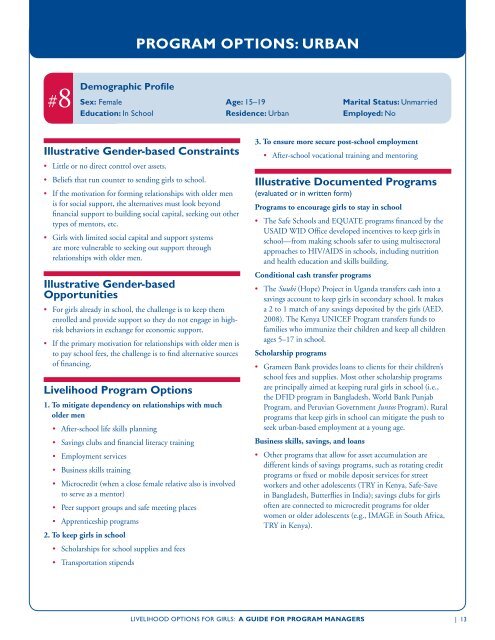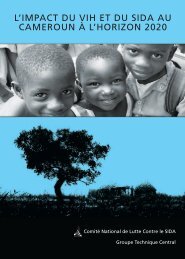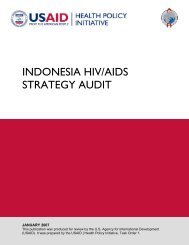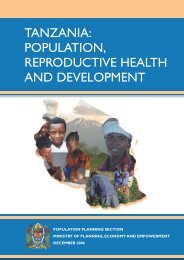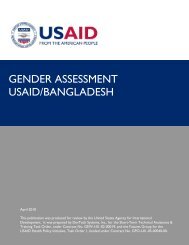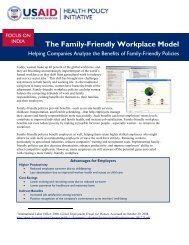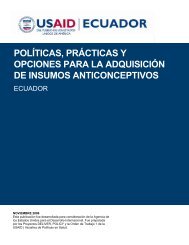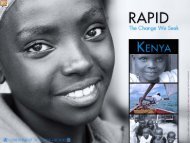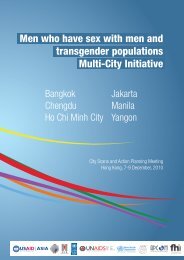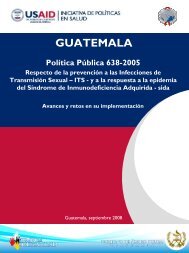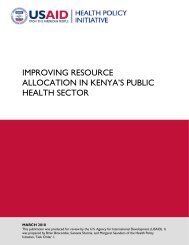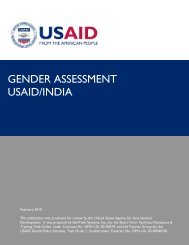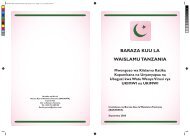LIVELIHOOD OPTIONS FOR GIRLS: - Health Policy Initiative
LIVELIHOOD OPTIONS FOR GIRLS: - Health Policy Initiative
LIVELIHOOD OPTIONS FOR GIRLS: - Health Policy Initiative
- No tags were found...
Create successful ePaper yourself
Turn your PDF publications into a flip-book with our unique Google optimized e-Paper software.
PROGRAM <strong>OPTIONS</strong>: URBAN8Demographic Profile# Sex: Female Age: 15–19 Marital Status: UnmarriedEducation: In School Residence: Urban Employed: NoIllustrative Gender-based Constraints• Little or no direct control over assets.• Beliefs that run counter to sending girls to school.• If the motivation for forming relationships with older menis for social support, the alternatives must look beyondfinancial support to building social capital, seeking out othertypes of mentors, etc.• Girls with limited social capital and support systemsare more vulnerable to seeking out support throughrelationships with older men.Illustrative Gender-basedOpportunities• For girls already in school, the challenge is to keep themenrolled and provide support so they do not engage in highriskbehaviors in exchange for economic support.• If the primary motivation for relationships with older men isto pay school fees, the challenge is to find alternative sourcesof financing.Livelihood Program Options3. To ensure more secure post-school employment• After-school vocational training and mentoringIllustrative Documented Programs(evaluated or in written form)Programs to encourage girls to stay in school• The Safe Schools and EQUATE programs financed by theUSAID WID Office developed incentives to keep girls inschool—from making schools safer to using multisectoralapproaches to HIV/AIDS in schools, including nutritionand health education and skills building.Conditional cash transfer programs• The Suubi (Hope) Project in Uganda transfers cash into asavings account to keep girls in secondary school. It makesa 2 to 1 match of any savings deposited by the girls (AED,2008). The Kenya UNICEF Program transfers funds tofamilies who immunize their children and keep all childrenages 5–17 in school.Scholarship programs• Grameen Bank provides loans to clients for their children’sschool fees and supplies. Most other scholarship programsare principally aimed at keeping rural girls in school (i.e.,the DFID program in Bangladesh, World Bank Punjab1. To mitigate dependency on relationships with much Program, and Peruvian Government Juntos Program). Ruralolder menprograms that keep girls in school can mitigate the push to• After-school life skills planning• Savings clubs and financial literacy training• Employment services• Business skills training• Microcredit (when a close female relative also is involvedto serve as a mentor)• Peer support groups and safe meeting places• Apprenticeship programs2. To keep girls in school• Scholarships for school supplies and fees• Transportation stipendsseek urban-based employment at a young age.Business skills, savings, and loans• Other programs that allow for asset accumulation aredifferent kinds of savings programs, such as rotating creditprograms or fixed or mobile deposit services for streetworkers and other adolescents (TRY in Kenya, Safe-Savein Bangladesh, Butterflies in India); savings clubs for girlsoften are connected to microcredit programs for olderwomen or older adolescents (e.g., IMAGE in South Africa,TRY in Kenya).<strong>LIVELIHOOD</strong> <strong>OPTIONS</strong> <strong>FOR</strong> <strong>GIRLS</strong>: A GUIDE <strong>FOR</strong> PROGRAM MANAGERS | 13


